HOME
PLANTS
Bamboo
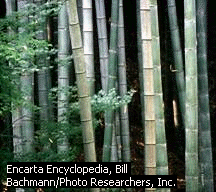 Bamboo
grows most abundantly in southeastern Asia where it has hundreds of
practical applications, such as in construction and decoration and as
paper or food. The plant's stems, called culms, consist of hollow
sections called internodes which are interrupted by regularly spaced
nodes, giving bamboo its jointed appearance.
Bamboo
grows most abundantly in southeastern Asia where it has hundreds of
practical applications, such as in construction and decoration and as
paper or food. The plant's stems, called culms, consist of hollow
sections called internodes which are interrupted by regularly spaced
nodes, giving bamboo its jointed appearance.
Bamboo is the
common name for about 45 genera and about 480 species of perennial,
woody, usually shrubby or treelike plants of the grass family.
Bamboos occur mostly in tropical and subtropical areas, from sea
level to snow-capped mountain peaks, with a few species reaching into
temperate areas. They are most abundant in southeastern Asia, with
some species in the Americas and Africa and none in Australia.
The plants range from stiff reeds about 1 m (about 3 ft) tall to
giants reaching 50 m (164 ft) in height and 30 cm (12 in) in diameter
near the base. Most bamboos are erect, but some are viny, producing
impenetrable thickets in some areas.
STRUCTURE AND CHARACTERISTICS
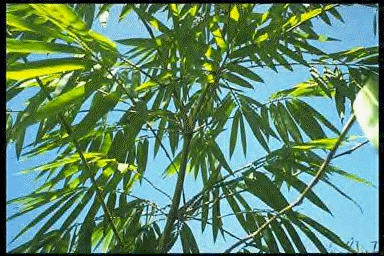 Bamboos
are easily recognized by their woody, jointed stems, called culms.
The culms consist of hollow sections called internodes, which are
interrupted by regularly spaced solid partitions
Bamboos
are easily recognized by their woody, jointed stems, called culms.
The culms consist of hollow sections called internodes, which are
interrupted by regularly spaced solid partitions 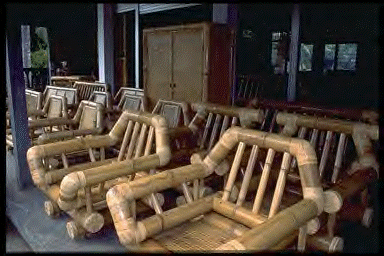 called
nodes. At each node a sheath protects a bud, which may develop into
either a branch or an inflorescence (flower cluster). Bamboo stems
develop from horizontal, underground rhizomes (thickened plant
stems). The tips of new shoots are protected by overlapping
scales, which are shed as the internodes elongate. Initially, new
shoots grow slowly, but the growth rate increases rapidly and
may reach
called
nodes. At each node a sheath protects a bud, which may develop into
either a branch or an inflorescence (flower cluster). Bamboo stems
develop from horizontal, underground rhizomes (thickened plant
stems). The tips of new shoots are protected by overlapping
scales, which are shed as the internodes elongate. Initially, new
shoots grow slowly, but the growth rate increases rapidly and
may reach 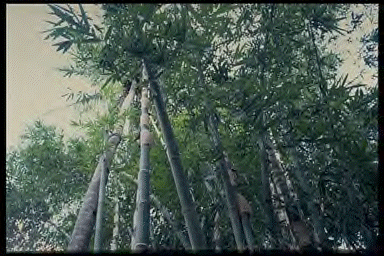 nearly
60 cm (24 in) per day in some gigantic tropical species. The
main shoot does not bear leaves and usually does not produce branches
until it is fully elongated. Branches grow from the buds present at
each node, and branches may themselves produce secondary or even
tertiary branches. It is on these ultimate branches that bamboos
produce their usually linear, flat, and many-veined leaves.
nearly
60 cm (24 in) per day in some gigantic tropical species. The
main shoot does not bear leaves and usually does not produce branches
until it is fully elongated. Branches grow from the buds present at
each node, and branches may themselves produce secondary or even
tertiary branches. It is on these ultimate branches that bamboos
produce their usually linear, flat, and many-veined leaves.
The culms of
bamboos are green because they contain abundant chlorophyll in the
tissue immediately below the surface. Thus, the culms serve as a
major photosynthetic surface, especially because they elongate before
the leaves themselves develop.
The floral
structure of bamboos is basically that of the grass family. Because
of details in the flowers, 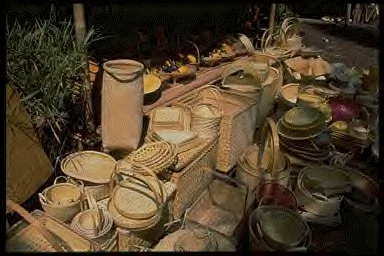 however,
bamboos are considered primitive among the grasses. That is, the
bamboos typically have three lodicules (scales at the base of an
ovary), six stamens, and three stigmas (the germination areas of the
pistil), rather than the two lodicules, three stamens, and two
stigmas typical of most grasses. In addition, although many bamboos
flower annually, many others flower only at intervals of 10 to 100 years.
All members of a particular species flower at the same time, and the
plants die shortly after flowering and setting their seed. The
individual species are perpetuated by the seed or by new culms
sprouted from rhizomes.
however,
bamboos are considered primitive among the grasses. That is, the
bamboos typically have three lodicules (scales at the base of an
ovary), six stamens, and three stigmas (the germination areas of the
pistil), rather than the two lodicules, three stamens, and two
stigmas typical of most grasses. In addition, although many bamboos
flower annually, many others flower only at intervals of 10 to 100 years.
All members of a particular species flower at the same time, and the
plants die shortly after flowering and setting their seed. The
individual species are perpetuated by the seed or by new culms
sprouted from rhizomes.
USES
 Bamboos
are among the plants most widely used by humans. In the tropics they
are used for constructing houses, rafts, bridges, and scaffolding.
Split and flattened culms can be used as flooring and interwoven to
make baskets, mats, hats, fish traps, and other articles; culms of
large species may be used as containers for liquids. Paper is made
from bamboo pulp, and fishing rods, water pipes, musical instruments,
and chopsticks from other parts. Many bamboos are planted as
ornamentals, and young shoots are eaten as a vegetable. The grain is
also a food..
Bamboos
are among the plants most widely used by humans. In the tropics they
are used for constructing houses, rafts, bridges, and scaffolding.
Split and flattened culms can be used as flooring and interwoven to
make baskets, mats, hats, fish traps, and other articles; culms of
large species may be used as containers for liquids. Paper is made
from bamboo pulp, and fishing rods, water pipes, musical instruments,
and chopsticks from other parts. Many bamboos are planted as
ornamentals, and young shoots are eaten as a vegetable. The grain is
also a food..
Contributed By: Marshall R. Crosby
Microsoft ® Encarta ®
Encyclopedia 2002. © 1993-2001 Microsoft Corporation. All rights reserved.
 Bamboo
grows most abundantly in southeastern Asia where it has hundreds of
practical applications, such as in construction and decoration and as
paper or food. The plant's stems, called culms, consist of hollow
sections called internodes which are interrupted by regularly spaced
nodes, giving bamboo its jointed appearance.
Bamboo
grows most abundantly in southeastern Asia where it has hundreds of
practical applications, such as in construction and decoration and as
paper or food. The plant's stems, called culms, consist of hollow
sections called internodes which are interrupted by regularly spaced
nodes, giving bamboo its jointed appearance. Bamboos
are easily recognized by their woody, jointed stems, called culms.
The culms consist of hollow sections called internodes, which are
interrupted by regularly spaced solid partitions
Bamboos
are easily recognized by their woody, jointed stems, called culms.
The culms consist of hollow sections called internodes, which are
interrupted by regularly spaced solid partitions  called
nodes. At each node a sheath protects a bud, which may develop into
either a branch or an inflorescence (flower cluster). Bamboo stems
develop from horizontal, underground rhizomes (thickened plant
stems). The tips of new shoots are protected by overlapping
scales, which are shed as the internodes elongate. Initially, new
shoots grow slowly, but the growth rate increases rapidly and
may reach
called
nodes. At each node a sheath protects a bud, which may develop into
either a branch or an inflorescence (flower cluster). Bamboo stems
develop from horizontal, underground rhizomes (thickened plant
stems). The tips of new shoots are protected by overlapping
scales, which are shed as the internodes elongate. Initially, new
shoots grow slowly, but the growth rate increases rapidly and
may reach  nearly
60 cm (24 in) per day in some gigantic tropical species. The
main shoot does not bear leaves and usually does not produce branches
until it is fully elongated. Branches grow from the buds present at
each node, and branches may themselves produce secondary or even
tertiary branches. It is on these ultimate branches that bamboos
produce their usually linear, flat, and many-veined leaves.
nearly
60 cm (24 in) per day in some gigantic tropical species. The
main shoot does not bear leaves and usually does not produce branches
until it is fully elongated. Branches grow from the buds present at
each node, and branches may themselves produce secondary or even
tertiary branches. It is on these ultimate branches that bamboos
produce their usually linear, flat, and many-veined leaves. however,
bamboos are considered primitive among the grasses. That is, the
bamboos typically have three lodicules (scales at the base of an
ovary), six stamens, and three stigmas (the germination areas of the
pistil), rather than the two lodicules, three stamens, and two
stigmas typical of most grasses. In addition, although many bamboos
flower annually, many others flower only at intervals of 10 to 100 years.
All members of a particular species flower at the same time, and the
plants die shortly after flowering and setting their seed. The
individual species are perpetuated by the seed or by new culms
sprouted from rhizomes.
however,
bamboos are considered primitive among the grasses. That is, the
bamboos typically have three lodicules (scales at the base of an
ovary), six stamens, and three stigmas (the germination areas of the
pistil), rather than the two lodicules, three stamens, and two
stigmas typical of most grasses. In addition, although many bamboos
flower annually, many others flower only at intervals of 10 to 100 years.
All members of a particular species flower at the same time, and the
plants die shortly after flowering and setting their seed. The
individual species are perpetuated by the seed or by new culms
sprouted from rhizomes. Bamboos
are among the plants most widely used by humans. In the tropics they
are used for constructing houses, rafts, bridges, and scaffolding.
Split and flattened culms can be used as flooring and interwoven to
make baskets, mats, hats, fish traps, and other articles; culms of
large species may be used as containers for liquids. Paper is made
from bamboo pulp, and fishing rods, water pipes, musical instruments,
and chopsticks from other parts. Many bamboos are planted as
ornamentals, and young shoots are eaten as a vegetable. The grain is
also a food..
Bamboos
are among the plants most widely used by humans. In the tropics they
are used for constructing houses, rafts, bridges, and scaffolding.
Split and flattened culms can be used as flooring and interwoven to
make baskets, mats, hats, fish traps, and other articles; culms of
large species may be used as containers for liquids. Paper is made
from bamboo pulp, and fishing rods, water pipes, musical instruments,
and chopsticks from other parts. Many bamboos are planted as
ornamentals, and young shoots are eaten as a vegetable. The grain is
also a food..